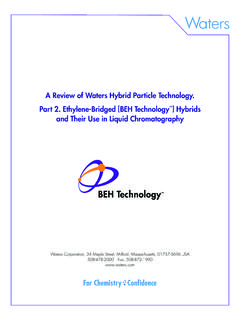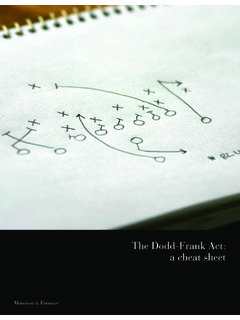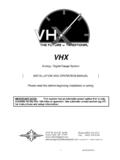Transcription of HISTORY OF LEAR - Lear Corporation
1 There was a Mr. Lear from which Lear Corporation derived its name. William Lear (1902-1978) was a noted self-taught inventor, who started by repairing radio sets in his home located in Quincy, Illinois, during the World War I era. He went on to invent the Learscope Direc-tion Finder, a radio triangulation device; the first commercial automobile radio for the company that would later become Motorola; the first practical lightweight beacon receiver for aircraft; and the Lear Jet Stereo 8 track tape in 1963, which was the precursor to cassette tapes.
2 In addition to many other innovations, his passion remained aviation and his success ultimately led to the founding of Lear Jets, the first company to manufacture a private, luxury aircraft, which debuted in 1963. Lear Corporation would get its name from this great innovator but its original corporate entity was American Metal Products (AMP), founded in Detroit by Fred Matthaei (1892-1973).On August 24th, 1917, at the age of 25, Matthaei began American Metal Products with one plant and 18 employees to manufacture tubular, welded and stamped steel assemblies for the automotive and aviation along with the demand for more cars, American Metal Products would manufacture the first seat frames with coil springs in 1928, incorporate the next year and break the $1 million sales mark in 1939.
3 By 1941, AMP had 12 customers and approximately 900 employees. Switching to military production at America s entry into World War II, wartime production resulted in sales of $11 million by 1944 and, with the post-war resurgence of domestic auto demand, sales grew to almost $31 million by 1950. This peacetime period was marked by producing seats for all Ford passenger cars, seats and axles for Chevrolet trucks as well as some propeller shafts for some Chevrolet plants among non-auto-motive end-consumer products. Innovation in seat springs led AMP to design its own machinery to make complex wire springs in 1950 and 2- and 3- way seat 4-way seat track adjuster was patented in 1952 and through acquisitions the next year AMP produced more than 4500 front seat assemblies and 1800 rear seat units made of tubular frames and zig-zag springs per day by the end of 1953.
4 Other innovations that followed shortly included the Universal Positioning Seat Adapter, the first Power Seat Track and the electric 6-way seat adjuster. The next year AMP moved into the Canadian market via acquisition of General Spring Products of Kitchener, 1957, AMP sales reached $ million, with about 5000 employees. The next year the Unison-Action truck seat was introduced, a seat with a contoured back moving in unison with the seat cushion to alleviate driver discomfort and 1963, AMP purchased the No-Sag Spring Company which gave it full or partial ownership of operations in Mexico, Germany, Brazil, England and Venezuela.
5 In addition to springs, the 1960s saw the first develop-ment and manufacture of a 6-way power seat mechanism and work on the first robotic resistance welding to be used for seat to concentrate on aviation and unable to convince others within the com-pany, William Lear sold his interest in Lear, Inc., to the Siegler Corporation in 1962, thus becoming Lear Siegler, Inc. (LSI), which would acquire AMP in 1966. By the late 1960s, LSI produced 25% of all automotive seat assem-blies and heavy truck axle housings and 20% of heavy truck and tractor seating within the and Canada.
6 Among its other innova-tions at the time were the in-cushion seat recliner mechanism; vertical seat adjuster and tilt device; and power headrest mechanisms. LSI established a Foam & Plastic Development Laboratory and in 1969 initiated a polyure-thane foam production line, an early venture into what would become a major business 1971, LSI had become the largest inde-pendent supplier of seating assemblies in the world and achieved sales of $900 million in 1977. Continuing to innovate in the late 1970s, LSI introduced Captain s Chairs (seats that swiveled on pedestal bases)
7 And the first non-welded aluminum seat frame and also began production of fully-trimmed seats for OF LEAR GUILFORD APPROVED LOGO bybyThe additions of Arada and Autonet provide technologies and expertise to move data from vehicle-to-vehicle and vehicle-to-infrastruc-ture, enhancing existing capabilities to capitalize fully on the connectivity mega-trend. In 2016, in light of this growth regarding connectivity and expanded electrical architecture offerings, Lear renamed its Electrical business segment as E-Systems to reflect not only leadership status in connected gateway modules which facilitate secure processing of all of a vehicle s electrical, electronic and data requirements but also the full portfolio that encompasses wire harnesses, terminals & connectors, complex electronic modules, power converters and inverters, battery chargers, 48-volt systems.
8 Wireless capabilities, software, cybersecurity, lighting modules and audio components. In September, the Company announced that it had entered into a strategic partnership with Tempronics, pursuant to which Lear obtained a minority equity interest in Tempronics and also secured exclusive rights to its thermoelectric seat heating and cooling technology for automotive applications. The year s fourth quarter marked considerable activity, first with Lear returning to the Company s Detroit roots with opening of a new Lear Innovation Center at 119 State Street in the city s historic Capitol Park district and the acquisition of AccuMED, a specialty fabric financial results demonstrated that Lear had its most successful year ever in 2016, with records in all key financial metrics and achieving the 7th consecutive year of improved financial results.
9 Including an invest-ment grade rating from Moody the future and strategic vision, Lear enters its 100th year focusing on three mega-trends that have emerged as major driv-ers of change and growth in the automotive industry: safety, efficiency and connectivity, with each of these trends converging toward fully connected vehicles and autonomous driving. This convergence reflects the strength of Lear s position for the future as the Company enters 2017 as the only seating supplier with electronics capabilities (including software).
10 Future seats will increasingly integrate elec-tronics, not only for motorized control but for dynamic sensing and response. These intelligent seating solutions, which we call Intelligent Seating (INTU Seating), will intuitively anticipate and dynamically adjust to the occupant s needs and preferences related to posture, health and wellness, comfort and safety. Today, Lear is the most profitable seating supplier with the most complete component capabilities of any of our competitors and, in addition to providing seat structures and mechanisms, provides leather, fabric and industry-leading seat cover sewing expertise.




